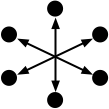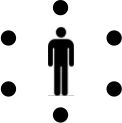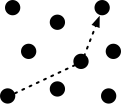Recently, Verizon and T-Mobile announced they would be shipping $50 Android phones quite soon. Technology pros know about Moore’s Law but often forget a critical aspect: it’s not just about increasing power, it’s also about decreasing cost.
The commoditization of smartphone hardware is just the beginning. Plunging prices of integrated “system on a chip” devices, paired with free Linux clones like Android, have enabled not just cheap devices, but,cheap cloud-based devices. This has applied to phone products like the Sony Ericsson LiveView, and also to home appliances like the Sonos home music system.
These examples are just the initial, telltale signs of a huge new wave of cheap devices about to invade our lives—a zombie apocalypse of electronics, if you will.
Imagining the potential impact of cheap computing devices isn’t a new idea; Don Norman discussed it in his book, The Invisible Computer, over ten years ago. And the proliferation of cheap devices isn’t a new concept, either; the ubiquitous computing (UbiComp) community has been discussing this even longer.
Taken together, these two trends, represent an interesting challenge, especially for the UX community. There is an apparent gulf between the commercial world of desktop computers and the “smart dust” science fiction visions of UbiComp. Now that we’re actually seeing real, viable, low cost products emerge, it’s as if we can’t really believe it—we’re still stuck in our old school ways of thinking about computing. The desktop paradigm seems to be binding us, preventing us from seeing new ways of working.
This is especially evident with mobile phones, which are definitely not desktop computers. Yet time and again, classic desktop apps are “ported” to mobile phones with little rethinking of how the mobile context would change, sometimes fundamentally, how that application will be used. I call this “Default Thinking,” and have written about it previously in The Inside Text: Social, Cultural and Design Perspectives on SMS. This problem is simple, but pernicious: designers think of new technologies in terms of yesterday’s tasks, failing to clearly see the real potential of the new technologies.
The Dynamo and the Computer
This slow painful change of technology paradigms isn’t new; it was described in 1989 by Paul David in his paper, The Dynamo and the Computer. Dynamo is an old-fashioned term for a very large, powerful electric motor (does anyone remember Iron Man’s nemesis, the Crimson Dynamo?). This large power source had several profound impacts on the industrial revolution.
The first was freedom from geography. Factories no longer needed to depend on rivers to generate their power. But this benefit was limited by the fact that factories had only a single, large dynamo, which required very clever pulley systems to distribute the power throughout the plant, making for a very convoluted workflow. So the next major advance arose from the falling prices and sizes of dynamos, which allowed them to be used in multiple locations throughout the factory without complex distribution mechanisms. This had a liberating effect, enabling the assembly line to finally escape the constraining pulley system. The power could flow around the process, not the other way around. This enabled significant increases in productivity.
In his paper, Paul David used dynamos as an analogy for what was happening in the office: instead of a single mainframe everyone had to work around, desktop computers were flowing into the office, conforming to and aiding the workflows of the modern office.
David’s crazy prediction, put forward In 1989, was that personal computers would allow everyone in an office to have the power of a mainframe at their disposal.
The Dynamo Today
The trend seen by David continues today, with devices getting even smaller and more numerous. In modern homes, there are small computing devices such as laptops, MP3 players, and mobile phones, but also more unexpected types of computerized devices such as smart TVs, stereos, cars systems, home heating controllers and, yes, even refrigerators. But that’s just the beginning. Key chains, credit cards, headsets, head-mounted displays, smart jewelry… hell, even smart blenders and knife sharpeners are not far behind.
These new smart devices are turning our original desktop-PC-as-hub model on its head. People used to choose between a Mac and a PC and then buy hundreds, if not thousands, of dollars of software, becoming locked into a single platform on a single device. But now there’s a different model forming in which people work with multiple devices on the same data, usually through the cloud.
An obvious example of this is email that can be read from both laptops and mobile phones, but it’s also cropping up in “mini-versions” of desktop apps on mobile phone and iPads—e.g., the iPad versions of Keynote and OmniGraffle.
Pandora pushes this idea even further, allowing users to listen to music on a wide variety of devices. This was brought home to me when my wife started using Pandora on her laptop, and when she got an iPhone, I installed the Pandora app for her. Her first comment about it made me smile: “How do I sync my music?” I just told her to sign in and then, as if by magic, all of her music appeared. She was amazed. It was kind of like buying a refrigerator and having it delivered full of food.
This Pandora story shows how powerful it can be to have an application’s data be in the cloud. But a shift in my wife’s way of thinking happened soon thereafter: while I was researching a new television, she told me to be sure to get one with Pandora. This is when I knew a potential shift was in place; instead of sticking to the of model of choosing the device first and then loading it with software, here was a case where software was not only driving device selection, but also encouraging the use of multiple devices as an integrated family. The world was inverted: our software is now dictating which hardware to buy.
As smart devices continue to increase in power and reduce in cost, size, and power requirements, this dynamo effect will continue, driving more technology around our processes than the other way around.
Devices Are Greater Than Apps
I’d like to be very clear: I’m not saying the current hot mobile apps like Facebook, Instagram, or Angry Birds will all be transformed by these new cheap devices. The zombie apocalypse is showing how new patterns are emerging, ones that will not likely be served by a classic “app on my phone” model.
The fundamental paradigm of the mobile phone app is basically exactly the same as has existed from the dawn of computing time: a single piece of software to install, open and interact with directly, and then put away. But the coming zombie apocalypse is revealing new UX patterns that will start to form from the connections and interactions between these devices. Three new patterns come to mind, but I expect more to form as this unfolds:
1. Fixed cluster
 A fixed cluster of devices will come into the home and encourage the use and transference of functionality between them. Pandora is a primitive version of this, and the Sonos sound system is another. Both of these systems stream music to multiple devices within the cluster. Pandora takes a one-at-time model where Sonos is working with more with a “swarm” of devices.
A fixed cluster of devices will come into the home and encourage the use and transference of functionality between them. Pandora is a primitive version of this, and the Sonos sound system is another. Both of these systems stream music to multiple devices within the cluster. Pandora takes a one-at-time model where Sonos is working with more with a “swarm” of devices.
However, both of these examples are just the beginning. Here is an imagined scenario that would push this concept further: while I’m working out, I’m listening to some exotic, crowdsourced playlist on my wireless headphones that is being streamed via my phone. When I get into my car, the music automatically transfers to my car stereo. When I get home, the music pauses while I walk into my house but once I dock my phone, it transfers into the house stereo system, which will play on the speakers nearest to me, and will follow me as I move around the house.
Of course, a fixed cluster can do more than just play music: it could regulate energy usage in the home, synchronize personal data (such as photos between cameras, phones and family), personalize settings for devices based on who is using it, to name just a few examples.
2. Personal cluster
 A second type of pattern will be swarms of devices on people’s bodies that will be able to collect data and collaborate. There is likely to be a two-tier caste system between a relatively small set of smart devices such as a phone, headset, watch, and shoes, alongside a much larger ragtag gaggle of “dumb” RFID devices that represent nearly everything a person is wearing and carrying.
A second type of pattern will be swarms of devices on people’s bodies that will be able to collect data and collaborate. There is likely to be a two-tier caste system between a relatively small set of smart devices such as a phone, headset, watch, and shoes, alongside a much larger ragtag gaggle of “dumb” RFID devices that represent nearly everything a person is wearing and carrying.
A classic example of this pattern is a “distributed phone,” where the basic communication brick containing the radio, main processor, and storage hide in the user’s pocket while an earpiece, watch, and jewelry work in concert to interact with the user and the central device. A smart watch can show message alerts and a photo caller ID, and subtler “Info-jewelry” could display information ambiently through color changes (e.g., different colors based on number of pending messages).
But even the “dumb” RFID tags people’s clothes could be read by one of their smart devices to become part of a larger, personal profile: who people are becomes an amalgam of what they’re wearing which could be shared by physical proximity but also projected to Web-based profiles. This applies to more that just clothing; it could involve any number of objects, each having an owner, so “who” you are wearing could be more interesting than what: objects associated with causes, movies, books, or pop artists, could each evoke a special message or buying opportunity.
3. Opportunistic cluster
 The previous two patterns involve fairly stable, known clusters under the user’s control. Another likely pattern will involve the entire world of smart devices that people will pass by throughout the day. Bus stops, rental cars, store kiosks, movie posters, and even entire buildings will offer value by allowing people to interact with them.
The previous two patterns involve fairly stable, known clusters under the user’s control. Another likely pattern will involve the entire world of smart devices that people will pass by throughout the day. Bus stops, rental cars, store kiosks, movie posters, and even entire buildings will offer value by allowing people to interact with them.
In this world, the idea of “an app” is ridiculously quaint, a little like Scotty speaking into the Macintosh mouse in Star Trek II. In a world of millions of smart devices, a UX lingua franca will be a necessity so any user can approach any device and be able to interact with it directly, without downloading a specific app.
In a sea of devices, we’ll likely need a display on our phone/tablet that lists (and most likely ranks) nearby devices that might be of interest. Selecting any one would allow that device to interact in any way it chooses. In this manner, the classic concept of “an app” will just be available on demand for any device or object a person happens to be in front of. The idea of a user downloading, managing, and launching apps will seem antiquated.
Some devices won’t even need computation to be “smart.” Just geotagging every bus stop in a city would allow people to walk up to any bus stop signpost and interact with it by looking up its exact location through a cloud service, creating “websites on demand” for individual physical spaces. The great benefit of these “dumb points” would be that since they’re very inexpensive to deploy, cloud devices and experiences could be deployed literally everywhere.
Conclusion
Some of these ideas are aggressively forward-looking, but most really aren’t technologically that complex. The very idea of what a device is and how it interacts with other devices has already started to change. Like most exponential trends, it is a subtle one that isn’t really obvious until it is nearly undeniable. The UX community needs to embrace this coming zombie apocalypse not because we need to invent the future, but that our past is holding us back. We’ll only really discover this future if we shed our default thinking of desktop computers.







